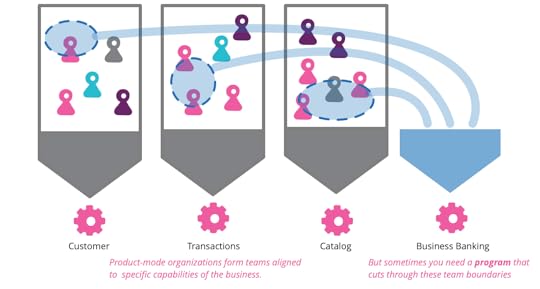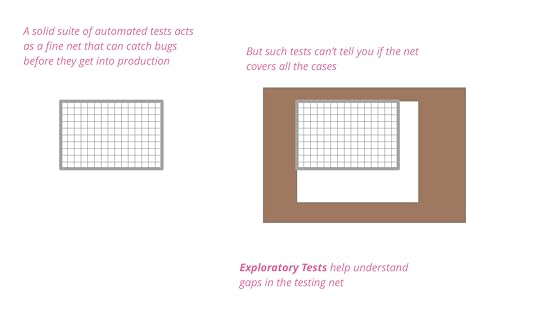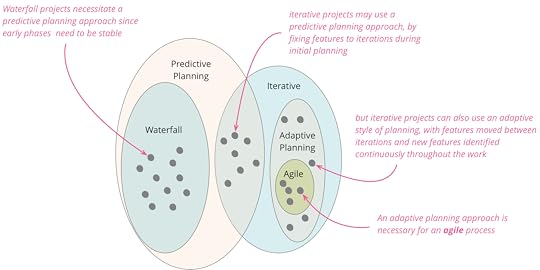Martin Fowler's Blog, page 13
January 13, 2020
How to manage a program in a product-mode organization

My colleagues often talk about the important advantages of organizing a
software development organization using products rather than projects.
While this is an effective organizational approach, it does have its
downsides. One of these is handling programs that require coordinating
across multiple product teams. Luiza Nunes and James Lewis share their
experiences dealing with this situation, outlining the kinds of problems
they see and the practices they've found to make it work.
November 18, 2019
Bliki: ExploratoryTesting
Exploratory testing is a style of testing that emphasizes a rapid cycle of
learning, test design, and test execution. Rather than trying to verify that
the software conforms to a pre-written test script, exploratory testing
explores the characteristics of the software, raising discoveries that will then be
classified as reasonable behavior or failures.
The exploratory testing mindset is a contrast to that of scripted
testing. In scripted testing, test designers create a script of tests, where
each manipulation of the software is written down, together with the expected
behavior of the software. These scripts are executed separately, usually many
times, and usually by different actors than those who wrote them. If any test
demonstrates behavior that doesn't match the expected behavior designed by the
test, then we consider this a failure.
For a long time scripted tests were usually executed by testers,
and you'd see lots of relatively junior folks in cubicles clicking through
screens following the script and checking the result. In large part due to the
influence of communities like Extreme Programming, there's been a
shift to automating scripted testing. This allows the tests to be executed
faster, and eliminates the human error involved in evaluating the expected
behavior. I've long been a firm advocate of automated testing like this, and
have seen great success with its use drastically reducing bugs.
But even the most determined automated testers realize that there are
fundamental limitations with the technique, which are limitations of any form
of scripted testing. Scripted testing can only verify what is in the script,
catching only conditions that are known about. Such tests can be a fine net that
catches any bugs that try to get through it, but how do we know that the net
covers all it ought to?
Exploratory testing seeks to test the boundaries of the net, finding new
behaviors that aren't in any of the scripts. Often it will find new failures
that can be added to the scripts, sometimes it exposes behaviors that are
benign, even welcome, but not thought of before.

Exploratory testing is a much more fluid and informal process than scripted
testing, but it still requires discipline to be done well. A good way to do
this is to carry out exploratory testing in time-boxed sessions. These
sessions focus on a particular aspect of the software. A charter that
identifies the target of the session and what information you hope to find is
a fine mechanism to provide this focus.


Elisabeth Hendrickson is
one of the most articulate exponents of exploratory testing, and her book is the first choice to dig for more
is the first choice to dig for more
information on how to do this well.
Such a charter can act as focus, but shouldn't attempt to define details of
what will happen in the session. Exploratory testing involves trying things,
learning more about what the software does, applying that learning to generate
questions and hypotheses, and generating new tests in the moment to gather
more information. Often this will spur questions outside the bounds of the
charter, that can be explored in later sessions.
Exploratory testing requires skilled and curious testers, who are
comfortable with learning about the software and coming up with new test
designs during a session. They also need to be observant, on the lookout for
any behavior that might seem odd, and worth further investigation. Often,
however, they don't have to be full-time testers. Some teams like to have the
whole team carry out exploratory testing, perhaps in pairs or in a single mob.
Exploratory testing should be a regular activity occurring throughout the
software development process. Sadly it's hard to find any guidelines on how
much should be done within a project. I'd suggest starting with a one hour
session every couple of weeks and see what kinds of information the sessions
unearth. Some teams like to arrange half-an-hour or so of exploratory testing
whenever they complete a story.
If you find bugs are getting through to production, that's a
sign that there are gaps in the testing regimen. It's worth looking at any bug
that escapes to production and thinking about what measures could be taken to
either prevent the bug from getting there, or detecting it rapidly when in
production. This analysis will help you decide whether you need more
exploratory testing. Bear in mind
that it will take time to build up the skill to do exploratory testing well, if you haven't
done much exploratory testing before.
I would consider it a red flag if a team
isn't doing exploratory testing at all - even if their automated testing was
excellent. Even the best automated testing is inherently scripted testing -
and that alone is not good enough.
Acknowledgements
Almost all I know about Exploratory Testing comes from Elisabeth
Hendrickson's fine book , which is also where I
, which is also where I
pinched the net metaphor from.
Aida Manna, Alex Fraser, Bharath Kumar Hemachandran, Chris Ford, Claire
Sudbery, Daniel Mondria, David Corrales, David Cullen, David Salazar
Villegas, Lina Zubyte, and Philip Peter
discussed drafts of this article on our internal mailing list.
November 12, 2019
Bliki: WaterfallProcess
In the software world, “waterfall” is commonly used to describe a style of
software process, one that contrasts with the ideas of iterative,
or agile styles. Like many well-known terms in software it's meaning is
ill-defined and origins are obscure - but I find its essential theme is
breaking down a large effort into phases based on activity.
It's not clear how the word “waterfall” became so prevalent, but most
people base its origin on a paper by Winston
Royce, in particular this figure:

Although this paper seems to be universally acknowledged as the source of
the notion of waterfall (based on the shape of the downward cascade of tasks),
the term “waterfall” never appears in the paper. It's not clear how the name
appeared later.
Royce’s paper describes his observations on the software development
process of the time (late 60s) and how the usual implementation steps could be
improved. [1] But “waterfall” has gone much
further, to be used as a general description of a style of software
development. For people like me, who speak at software conferences, it almost
always only appears in a derogatory manner - I can’t recall hearing any
conference speaker saying anything good about waterfall for many years.
However when talking to practitioners in enterprises I do hear of it spoken as
a viable, even preferred, development style. Certainly less so now that in the
90s, but more frequently than one might assume by listening to process
mavens.
But what exactly is “waterfall”? That’s not an easy question to answer as,
like so many things in software, there is no clear definition. In my
judgment, there is one common characteristic that dominates any definition
folks use for waterfall, and that’s the idea of decomposing effort into phases
based on activity.
Let me unpack that phrase. Let’s say I have some software to build, and I
think it’s going to take about a year to build it. Few people are going to
happily say “go away for a year and tell me when its done”. Instead, most
people will want to break down that year into smaller chunks, so they can
monitor progress and have confidence that things are on track. The question
then is how do we perform this break down?
The waterfall style, as suggested by the Royce sketch, does it by the
activity we are doing. So our 1 year project might be broken down into 2
months of analysis, followed by 4 months design, 3 months of coding, and 3
months of testing. The contrast here is to an iterative style, where we would
take some high level requirements (build a library management system), and
divide them into subsets (search catalog, reserve a book, check-out and
return, assess fines). We'd then take one of these subsets and spend a couple
of months to build working software to implement that functionality,
delivering either into a staging environment or preferably into a live
production setting. Having done that with one subset, we'd continue with
further subsets.

In this thinking waterfall means “do one activity at a time for all the
features” while iterative means “do all activities for one feature at a time”.
If the origin of the word “waterfall” is murky, so is the notion of how
this phase-based breakdown originated. My guess is that it’s natural to break
down a large task into different activities, especially if you look to
activities such as building construction as an inspiration. Each activity
requires different skills, so getting all the analysts to complete analysis
before you bring in all the coders makes intuitive sense. It seems
logical that a misunderstanding of requirements is cheaper to fix before
people begin coding - especially considering the state of computers in the
late 60s. Finally the same activity-based breakdown can be used as a standard
for many projects, while a feature-based breakdown is harder to teach. [2]
Although it isn’t hard to find people explain why this waterfall thinking
isn’t a good idea for software development, I should summarize my primary
objections to the waterfall style
here.
The waterfall style usually has testing and integration as two of the final
phases in the cycle, but these are the most difficult to predict elements in a
development project. Problems at these stages lead to rework of many steps of
earlier phases, and to significant project delays. It's too easy to declare
all but the late phases as "done", with much work missing, and thus it's hard
to tell if the project is going well.
There is no opportunity for early releases before all features are done. All this
introduces a great deal of risk to the development effort.
Furthermore, a waterfall approach forces us into a predictive style of
planning, it assumes that once you are done with a phase, such as requirements
analysis, the resulting deliverable is a
stable platform for later phases to base their work on. [3] In practice the vast
majority of software projects find they need to change their requirements
significantly within a few months, due to everyone learning more about the
domain, the characteristics of the software environment, and changes in the
business environment. Indeed we've found that
delivering a subset of features does more than anything to help clarify what
needs to be done next, so an iterative approach allows us to shift to an
adaptive planning approach where we update our plans as we learn what the
real software needs are. [4]
These are the major reasons
why I've glibly said that "you should use iterative development only in projects that
you want to succeed".
Waterfalls and iterations may nest inside each other. A six year project
might consist of two 3 year projects, where each of the two projects are
structured in a waterfall style, but the second project adds additional
features. You can think of this as a two-iteration project at the top level
with each iteration as a waterfall. Due to the large size and small number of
iterations, I'd regard that as primarily a waterfall project. In contrast you
might see a project with 16 iterations of one month each, where each
iteration is planned in a waterfall style. That I'd see as primarily
iterative. While in theory there's potential for a middle ground projects that
are hard to classify, in practice it's usually easy to tell that one style
predominates.
It is possible for a mix of waterfall and iterative where early phases
(requirements analysis, high level design) are done in a waterfall style while
later phases (detailed design, code, test) are done in an iterative manner.
This reduces the risks inherent in late testing and integration phases, but
does not enable adaptive planning.
Waterfall is often cast as the alternative to agile software development,
but I don't see that as strictly true. Certainly agile processes require an
iterative approach and cannot work in a waterfall style. But it is easy to
follow an iterative approach (i.e. non-waterfall) but not be agile. [5] I might do
this by taking 100 features and dividing them up into ten iterations over the
next year, and then expecting that each iteration should complete on time with
its planned set of features. If I do this, my initial plan is a predictive
plan, if all goes well I should expect the work to closely follow the plan. But
adaptive planning is an essential element of
agile thinking. I expect features to move between iterations, new features to
appear, and many features to be discarded as no longer valuable enough.g

My rule of thumb is that anyone who
says “we were successful because we were on-time and on-budget” is
thinking in terms of predictive planning, even if they are following an
iterative process, and thus is not thinking with an agile mindset.
In the agile world, success is all about business value - regardless of what
was written in a plan months ago. Plans are made, but updated regularly. They guide
decisions on what to do next, but are not used as a success measure.
Notes
1:
There have been quite a few people seeking to interpret the Royce paper.
Some argue that his paper opposes waterfall, pointing out that the
paper discusses flaws in the kind of process suggested by the figure 2
that I've quoted here. Certainly he does discuss flaws, but he also says
the illustrated approach is "fundamentally sound". Certainly this
activity-based decomposition of projects became the accepted model in the
decades that followed.
2:
This leads to another common characteristic that goes with the term
“waterfall” - rigid processes that tell everyone in detail what they
should do. Certainly the software process folks in the 90s were keen on
coming up with prescriptive methods, but such prescriptive thinking also
affected many who advocated iterative techniques. Indeed although agile
methods explicitly disavow this kind of Taylorist
thinking, I often hear of faux-agile
initiatives following this route.
3:
The notion that a phase should be finished before the next one is started
is a convenient fiction. Even the most eager waterfall
proponent would agree that some rework on prior stages is necessary in
practice, although I think most would say that if executed perfectly, each
activity wouldn't need rework. Royce's paper explicitly discussed how
iteration was expected between adjacent steps (eg Analysis and Program
Design in his figure). However Royce argued that longer backtracks (eg
between Program Design and Testing) were a serious problem.
4:
This does raise the question of whether there are contexts where
the waterfall style is actually better than the iterative one. In theory,
waterfall might well work better in situations where there was a deep
understanding of the requirements, and the technologies being used - and
neither of those things would significantly change during the life of the
product. I say "in theory" because I've not come across such a
circumstance, so I can't judge if waterfall would be appropriate in
practice. And even then I'd be reluctant to follow the waterfall style for
the later phases (code-test-integrate) as I've found so much value in
interleaving testing with coding while doing continuous integration..
5:
In the 90s it was generally accepted in the object-oriented world that
waterfall was a bad idea and should be replaced with an iterative style.
However I don't think there was the degree of embracing changing
requirements that appeared with the agile community.
Acknowledgements
My thanks to
Ben Noble, Clare Sudbury, David Johnston, Karl Brown, Kyle Hodgson, Pramod Sadalage, Prasanna Pendse, Rebecca Parsons, Sriram Narayan, Sriram Narayanan, Tiago Griffo, Unmesh Joshi, and Vidhyalakshmi
Narayanaswamy
who discussed drafts of this post on our internal
mailing list.
October 27, 2019
photostream 122
September 19, 2019
Using CD4ML to evolve without bias

Danilo, Arif and Christoph finish their article on Continuous Delivery
for Machine Learning with a peek at the future of platform thinking and
how we might use CD4ML to help evolve intelligent systems without bias.
September 18, 2019
Data Versioning and Pipelines in CD4ML

My colleagues continue their article on Continuous Delivery for Machine
Learning by looking at the future, considering what further work needs to
be done in Data Versioning and Data Pipelines.
September 11, 2019
Orchestration and Observability in CD4ML

Danilo, Arif and Christoph finish the technical components of
Continuous Delivery for Machine Learning with the last two items:
Continuous Delivery Orchestration, and Model Monitoring and Observability
September 9, 2019
Experiments Tracking and Model Deployment in CD4ML

The team tackles some more technical components of
Continuous Delivery for Machine Learning. This time they look at
Experiments Tracking and Model Deployment.
The actual cost of lock-in and how to reduce it

Gregor completes his article by totting up the total cost of avoiding
lock-in, and considering some examples of the decisions around lock-in.
September 6, 2019
Serving and testing models in CD4ML

My colleagues continue their discussion of the technical components of
Continuous Delivery for Machine Learning. This installment looks at model
serving, testing, and quality.
Martin Fowler's Blog
- Martin Fowler's profile
- 1103 followers




